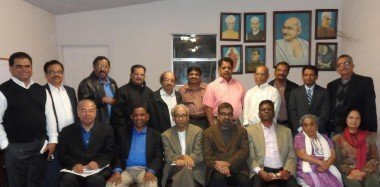കേരളാ റൈറ്റേഴ്സ് ഫോറം ചര്ച്ച: മാര്ത്താണ്ഡ വര്മ്മ മുതല് മണ്റൊ വരെ...
എ.സി. ജോര്ജ് Published on 05 February, 2015

ഹ്യൂസ്റ്റന്: ഹ്യൂസ്റ്റന് കേന്ദ്രമായി പ്രവര്ത്തിക്കുന്ന
എഴുത്തുകാരുടേയും നിരൂപകരുടേയും വായനക്കാരുടേയും ആസ്വാദകരുടേയും സംയുക്ത
സംഘടനയായ കേരളാ റൈറ്റേഴ്സ് ഫോറം ജനുവരി 31-ാം തീയതി വൈകുന്നേരം
ഹ്യൂസ്റ്റനിലെ സ്റ്റാഫോര്ഡിലുള്ള കേരളാ ഹൗസ് ഓഡിറ്റോറിയത്തില് വെച്ച്
പ്രതിമാസ ചര്ച്ചാ സമ്മേളനം നടത്തി. കേരളാ റൈറ്റേഴ്സ് ഫോറം പ്രസിഡന്റ്
ജോണ് മാത്യുവിന്റെ അധ്യക്ഷതയില് പതിവുപോലെയുള്ള ബിസിനസ് മീറ്റിംഗില്
സെക്രട്ടറി മാത്യു മത്തായി റിപ്പോര്ട്ട് അവതരിപ്പിച്ചു.
തുടര്ന്നുള്ള സാഹിത്യ-സാംസ്ക്കാരിക ചര്ച്ചാ സമ്മേളനത്തില് അധ്യക്ഷനായി ഡോക്ടര് മാത്യു വൈരമണ് യോഗനടപടികള് നിയന്ത്രിച്ചു. ഇപ്രാവശ്യത്തെ മുഖ്യവിഷയം മാര്ത്താണ്ഡവര്മ്മ മുതല് മണ്റൊ വരെ എന്ന തിരുവിതാംകൂര് രാജഭരണത്തെ ആസ്പദമാക്കിയുള്ള ഒരു ചരിത്രാവലോകനമായിരുന്നു. എഴുത്തുകാരനും ചരിത്രപണ്ഡിതനുമായ ഡോക്ടര് സണ്ണി എഴുമറ്റൂര് ഈ വിഷയത്തെപ്പറ്റി മുഖ്യപ്രഭാഷണം നടത്തി.
തിരുവിതാംകൂര് ഭരണചരിത്രത്തിലെ ഏറ്റവും ശക്തനായ മാര്ത്താണ്ഡവര്മ്മ മഹാരാജാവ്, എട്ടുവീട്ടില് പിള്ളമാര് തുടങ്ങിയ എല്ലാ വിമതരേയും വധിച്ചും ഒതുക്കിയും തിരുവിതാംകൂറിനു സമീപമുള്ള കൊച്ചു കൊച്ചു രാജ്യങ്ങളെ കീഴടക്കി തിരുവിതാംകൂറിന്റെ വിസ്തൃതി വര്ദ്ധിപ്പിച്ചു. അതീവ കര്ക്കശക്കാരനും സൂത്രശാലിയും അഭ്യാസിയുമായ വേലുത്തമ്പിയെ അദ്ദേഹം ദളവയായി നിയമിച്ചു.
എന്നാല് ശത്രുക്കളുടെ പിടിയില് പെടാതി രിക്കാന് വേലുത്തമ്പിക്ക് അത്മഹത്യ ചെയ്യേണ്ടി വന്നു. മാര്ത്താണ്ഡവര്മ്മക്കു ശേഷം ധര്മ്മരാജാവും ബാലരാമവര്മ്മ രാജാവും തിരുവിതാംകൂറില് പല ഭരണപരിഷ്ക്കാരങ്ങളും വരുത്തി. തുടര്ന്നു വന്ന റാണി ഗൗരി ലക്ഷ്മിഭായ് തന്റെ മുഖ്യ ദളവായായിരുന്ന ഉമ്മിണി തമ്പിയെ ഡിസ്മിസ് ചെയ്തു ബ്രിട്ടീഷുകാരനായ കേണല് ജോണ് മണ്റോയെ തന്റെ മുഖ്യ ഉപദേശകനാക്കി. ദളവാ എന്ന പദത്തിനു പകരം മുഖ്യ ഉപദേശകനും ഭരണകര്ത്താവുമായ വ്യക്തിയെ ദിവാന്ജി എന്നു വിളിച്ചു.
അങ്ങനെ തിരുവിതാംകൂര് രാജഭരണത്തിലെ ആദ്യത്തെ ദിവാന്ജിയായി കേണല് മണ്റൊയുടെ വരവോടെ ഭരണസംവിധാനത്തില് വേഗതയും നീതിനിഷ്ഠയും അല്പ്പമെങ്കിലും ദൃശ്യമായി. ദിവാന് ബ്രാഹ്മണന് ആയിരിക്കണമെന്ന നിബന്ധനയെ മറികടന്നാണ് മണ്റൊയെ റാണി ആ സ്ഥാനത്ത് നിയമിച്ചത്. സമൂഹത്തിലെ താഴ്ന്ന ജാതിക്കാര്ക്കും ദുര്ബലര്ക്കും മാത്രമായി ചുമത്തിയിരുന്ന തികച്ചും അന്യായ നികുതികളായ തലക്കരം, വലക്കരം, മുലക്കരം, വള്ളക്കരം തുടങ്ങിയവ നിര്ത്തലാക്കി. സമൂഹത്തിലെ താഴെക്കിടയിലുള്ളവര്ക്ക് അല്പ്പമെങ്കിലും ആശ്വാസം പകര്ന്നത് കേണല് മണ്റൊയുടെ ഭരണപരിഷ്ക്കാരങ്ങളായിരുന്നുവെന്ന് ഡോക്ടര് സണ്ണി എഴുമറ്റൂര്പറഞ്ഞു.
.
തുടര്ന്ന് ഒക്കല്ഹോമയില് നിന്നെത്തിയ പ്രമുഖ എഴുത്തുകാരന് ജോണ് എബ്രഹാം ആ കാലഘട്ടത്തെക്കുറിച്ച് പ്രചുര പ്രചാരത്തിലുള്ള പല ചരിത്രസംഭവങ്ങളേയും വിശകലനം ചെയ്തു സംസാരിച്ചു.
കേരളത്തിലെ പുരാവസ്തുക്കളേയും കലകളേയും ഉപകരണങ്ങളേയും പറ്റിയുള്ള ഒരു എക്സിബിഷന് അമേരിക്കയിലങ്ങോളമിങ്ങോളം സംഘടിപ്പിക്കുന്ന ഒരു ദൗത്യം സ്വയം ഏറ്റെടുത്തിരിക്കുകയാണെന്ന് അദ്ദേഹം തന്റെ പ്രസംഗത്തില് പറഞ്ഞു. ശ്രോതാക്കള് കയ്യടിയോടെ അദ്ദേഹത്തിന്റെ ഈ നവീന ദൗത്യത്തിന് പിന്തുണ അറിയിച്ചു.
തുടര്ന്നുള്ള ചര്ച്ചയില് സാമൂഹ്യ-സാംസ്ക്കാരിക മണ്ഡലങ്ങളിലെ പ്രമുഖരും എഴുത്തുകാരുമായ ടി.ജെ. ഫിലിപ്പ്, ജോണ് മാത്യു, എ.സി.ജോര്ജ്, ബാബു കുരവക്കല്, മേരി കുരവക്കല്, ദേവരാജ് കുറുപ്പ്, പീറ്റര് ജി. പൗലോസ്, സുരേന്ദ്രന് കോരന്, മാത്യു മത്തായി, ഈശൊ ജേക്കബ്, ജോസഫ് തച്ചാറ, ജോസഫ് മണ്ടപം, ബോബി മാത്യു, ടൈറ്റസ് ഈപ്പന്, ചാക്കൊ മുട്ടുങ്കല് തുടങ്ങിയവര് സംസാരിച്ചു. ഇന്നത്തേതുപോലെ അക്കാലത്ത് ചരിത്രം രേഖപ്പെടുത്താന് ശരിയായ മാര്ഗ്ഗങ്ങളില്ലായിരുന്നുവെന്നു മാത്രമല്ല ഭരണകര്ത്താക്കളുടേയും വരേണ്യവര്ഗ്ഗത്തിന്റെയും അഭീഷ്ടങ്ങള് അനുസരിച്ചാണ് ചരിത്രങ്ങള് രേഖപ്പെടുത്തിയിരിക്കുന്നതെന്ന് എല്ലാവരും അഭിപ്രായപ്പെട്ടു. വിവിധ തരത്തില് മാധ്യമങ്ങള് ഇത്രയധികം വളര്ന്നിട്ടുപോലും നമ്മുടെ കണ്മുമ്പില് വെച്ചു തന്നെ വാര്ത്തകളും ചരിത്രങ്ങളും മാറിമറയുന്നില്ലെ, വളച്ചൊടിക്കപ്പെടുന്നില്ലെ, വെള്ളം ചേര്ക്കപ്പെടുന്നില്ലേയെന്ന് ചര്ച്ചയില് പങ്കെടുത്തവര് ചോദിച്ചു. ഏകദേശം മൂന്നു മണിക്കൂറോളം ഈ ചര്ച്ചാസമ്മേളനം നീണ്ടുനിന്നു.
തുടര്ന്നുള്ള സാഹിത്യ-സാംസ്ക്കാരിക ചര്ച്ചാ സമ്മേളനത്തില് അധ്യക്ഷനായി ഡോക്ടര് മാത്യു വൈരമണ് യോഗനടപടികള് നിയന്ത്രിച്ചു. ഇപ്രാവശ്യത്തെ മുഖ്യവിഷയം മാര്ത്താണ്ഡവര്മ്മ മുതല് മണ്റൊ വരെ എന്ന തിരുവിതാംകൂര് രാജഭരണത്തെ ആസ്പദമാക്കിയുള്ള ഒരു ചരിത്രാവലോകനമായിരുന്നു. എഴുത്തുകാരനും ചരിത്രപണ്ഡിതനുമായ ഡോക്ടര് സണ്ണി എഴുമറ്റൂര് ഈ വിഷയത്തെപ്പറ്റി മുഖ്യപ്രഭാഷണം നടത്തി.
തിരുവിതാംകൂര് ഭരണചരിത്രത്തിലെ ഏറ്റവും ശക്തനായ മാര്ത്താണ്ഡവര്മ്മ മഹാരാജാവ്, എട്ടുവീട്ടില് പിള്ളമാര് തുടങ്ങിയ എല്ലാ വിമതരേയും വധിച്ചും ഒതുക്കിയും തിരുവിതാംകൂറിനു സമീപമുള്ള കൊച്ചു കൊച്ചു രാജ്യങ്ങളെ കീഴടക്കി തിരുവിതാംകൂറിന്റെ വിസ്തൃതി വര്ദ്ധിപ്പിച്ചു. അതീവ കര്ക്കശക്കാരനും സൂത്രശാലിയും അഭ്യാസിയുമായ വേലുത്തമ്പിയെ അദ്ദേഹം ദളവയായി നിയമിച്ചു.
എന്നാല് ശത്രുക്കളുടെ പിടിയില് പെടാതി രിക്കാന് വേലുത്തമ്പിക്ക് അത്മഹത്യ ചെയ്യേണ്ടി വന്നു. മാര്ത്താണ്ഡവര്മ്മക്കു ശേഷം ധര്മ്മരാജാവും ബാലരാമവര്മ്മ രാജാവും തിരുവിതാംകൂറില് പല ഭരണപരിഷ്ക്കാരങ്ങളും വരുത്തി. തുടര്ന്നു വന്ന റാണി ഗൗരി ലക്ഷ്മിഭായ് തന്റെ മുഖ്യ ദളവായായിരുന്ന ഉമ്മിണി തമ്പിയെ ഡിസ്മിസ് ചെയ്തു ബ്രിട്ടീഷുകാരനായ കേണല് ജോണ് മണ്റോയെ തന്റെ മുഖ്യ ഉപദേശകനാക്കി. ദളവാ എന്ന പദത്തിനു പകരം മുഖ്യ ഉപദേശകനും ഭരണകര്ത്താവുമായ വ്യക്തിയെ ദിവാന്ജി എന്നു വിളിച്ചു.
അങ്ങനെ തിരുവിതാംകൂര് രാജഭരണത്തിലെ ആദ്യത്തെ ദിവാന്ജിയായി കേണല് മണ്റൊയുടെ വരവോടെ ഭരണസംവിധാനത്തില് വേഗതയും നീതിനിഷ്ഠയും അല്പ്പമെങ്കിലും ദൃശ്യമായി. ദിവാന് ബ്രാഹ്മണന് ആയിരിക്കണമെന്ന നിബന്ധനയെ മറികടന്നാണ് മണ്റൊയെ റാണി ആ സ്ഥാനത്ത് നിയമിച്ചത്. സമൂഹത്തിലെ താഴ്ന്ന ജാതിക്കാര്ക്കും ദുര്ബലര്ക്കും മാത്രമായി ചുമത്തിയിരുന്ന തികച്ചും അന്യായ നികുതികളായ തലക്കരം, വലക്കരം, മുലക്കരം, വള്ളക്കരം തുടങ്ങിയവ നിര്ത്തലാക്കി. സമൂഹത്തിലെ താഴെക്കിടയിലുള്ളവര്ക്ക് അല്പ്പമെങ്കിലും ആശ്വാസം പകര്ന്നത് കേണല് മണ്റൊയുടെ ഭരണപരിഷ്ക്കാരങ്ങളായിരുന്നുവെന്ന് ഡോക്ടര് സണ്ണി എഴുമറ്റൂര്പറഞ്ഞു.
.
തുടര്ന്ന് ഒക്കല്ഹോമയില് നിന്നെത്തിയ പ്രമുഖ എഴുത്തുകാരന് ജോണ് എബ്രഹാം ആ കാലഘട്ടത്തെക്കുറിച്ച് പ്രചുര പ്രചാരത്തിലുള്ള പല ചരിത്രസംഭവങ്ങളേയും വിശകലനം ചെയ്തു സംസാരിച്ചു.
കേരളത്തിലെ പുരാവസ്തുക്കളേയും കലകളേയും ഉപകരണങ്ങളേയും പറ്റിയുള്ള ഒരു എക്സിബിഷന് അമേരിക്കയിലങ്ങോളമിങ്ങോളം സംഘടിപ്പിക്കുന്ന ഒരു ദൗത്യം സ്വയം ഏറ്റെടുത്തിരിക്കുകയാണെന്ന് അദ്ദേഹം തന്റെ പ്രസംഗത്തില് പറഞ്ഞു. ശ്രോതാക്കള് കയ്യടിയോടെ അദ്ദേഹത്തിന്റെ ഈ നവീന ദൗത്യത്തിന് പിന്തുണ അറിയിച്ചു.
തുടര്ന്നുള്ള ചര്ച്ചയില് സാമൂഹ്യ-സാംസ്ക്കാരിക മണ്ഡലങ്ങളിലെ പ്രമുഖരും എഴുത്തുകാരുമായ ടി.ജെ. ഫിലിപ്പ്, ജോണ് മാത്യു, എ.സി.ജോര്ജ്, ബാബു കുരവക്കല്, മേരി കുരവക്കല്, ദേവരാജ് കുറുപ്പ്, പീറ്റര് ജി. പൗലോസ്, സുരേന്ദ്രന് കോരന്, മാത്യു മത്തായി, ഈശൊ ജേക്കബ്, ജോസഫ് തച്ചാറ, ജോസഫ് മണ്ടപം, ബോബി മാത്യു, ടൈറ്റസ് ഈപ്പന്, ചാക്കൊ മുട്ടുങ്കല് തുടങ്ങിയവര് സംസാരിച്ചു. ഇന്നത്തേതുപോലെ അക്കാലത്ത് ചരിത്രം രേഖപ്പെടുത്താന് ശരിയായ മാര്ഗ്ഗങ്ങളില്ലായിരുന്നുവെന്നു മാത്രമല്ല ഭരണകര്ത്താക്കളുടേയും വരേണ്യവര്ഗ്ഗത്തിന്റെയും അഭീഷ്ടങ്ങള് അനുസരിച്ചാണ് ചരിത്രങ്ങള് രേഖപ്പെടുത്തിയിരിക്കുന്നതെന്ന് എല്ലാവരും അഭിപ്രായപ്പെട്ടു. വിവിധ തരത്തില് മാധ്യമങ്ങള് ഇത്രയധികം വളര്ന്നിട്ടുപോലും നമ്മുടെ കണ്മുമ്പില് വെച്ചു തന്നെ വാര്ത്തകളും ചരിത്രങ്ങളും മാറിമറയുന്നില്ലെ, വളച്ചൊടിക്കപ്പെടുന്നില്ലെ, വെള്ളം ചേര്ക്കപ്പെടുന്നില്ലേയെന്ന് ചര്ച്ചയില് പങ്കെടുത്തവര് ചോദിച്ചു. ഏകദേശം മൂന്നു മണിക്കൂറോളം ഈ ചര്ച്ചാസമ്മേളനം നീണ്ടുനിന്നു.


Facebook Comments
Comments
Aniyankunju 2015-02-05 16:44:52
There are factual mistakes in the Kerala History quoted in this article. Given below is excerpts from authentic History of Travancore. For example, Marthanda Varma ruled during 1729-1758, and Velu Thampi was Divan during 1799-1809.
".......The history of Travancore begins with Marthanda Varma who inherited the kingdom of Venad, and expanded it into Travancore during his reign 1729– 1758.
The rulers of Travancore were Malayala Kshatriyas belonging to Samanthan Nair caste. The Samanthan Nairs (Nambiars, Adiyodees, Pillai, Kurups etc.) followed a matrilineal system of inheritance known as "Marumakkathayam".
Marthanda Varma was a powerful ruler who expanded Venad from Kanyakumari in the south to Idappally in the north during his 29 year rule. He signed a treaty with the British East India Company and with their help destroyed the power of the eight feudal land lords called Ettuveetil Pillamar and "Ettara Yogam" who supported the Thampi sons of the previous king of Venad, Rajah Rama Varma.
In successive battles, Marthanda Varma defeated and absorbed the kingdoms right up to Cochin kingdom including Attingal, Kollam, Kayamkulam, Kottarakara, Kottayam, Pandalam, Poonjar and Chempakassery. He succeeded in defeating the Dutch East India Company during the Travancore-Dutch War (1739–1753), the most decisive engagement of which was the Battle of Colachel (10 August, 1741) in which the Dutch Admiral Eustachius De Lannoy was captured.
On January 3, 1750, (5 Makaram, 925 Kollavarsham), Marthanda Varma virtually "dedicated" Travancore to his tutelary deity Padmanabha of Padmanabhaswamy Temple (the Trippadidaanam) and from then on the rulers of Travancore ruled as the "servants of Padmanabha" (the Padmnabha-dasans).
In 1753, the Dutch signed a peace treaty with Marthanda Varma. With Battle of Ambalapuzha (3 January, 1754) in which he defeated the union of the deposed Kings and the king of Cochin kingdom, Marthanda Varma crushed all opposition to his rule. In 1757, after the Cochin Travancore War (1755–1756), a treaty was concluded between Travancore and Cochin kingdom, ensuring stability on the northern border.
Marthanda Varma organised the tax system and constructed many irrigation works in his kingdom. Admiral Eustachius De Lannoy, who was captured as a prisoner of war in the famous Battle of Colachel was appointed as the Senior Admiral ("Valiya kappittan") and he modernised the Travancore army by introducing firearms and artillery. Ayyappan Marthanda Pillai served as the "Sarvadi Karykar" (Head of the Army). Marthanda Varma introduced titles such as Chempaka Raman and honours such as Ettarayum Koppum to honour the lords and his relatives who had remained faithful to him during his internal problems with the Ettuveetil Pillamar. His able Prime Minister during his entire military career was Ramayyan Dalawa.
Marthanda Varma's successor Karthika Thirunal Rama Varma (1758-1798) who was popularly known as Dharma Raja, shifted the capital in 1795 from Padmanabhapuram to Thiruvananthapuram. Dharma Raja's period is considered as a Golden Age in the history of Travancore. He not only retained the territorial gains of his predecessor Marthanda Varma, but also improved and encouraged social developments. He was greatly assisted by a very efficient administrator, Raja Kesavadas, who was the Diwan of Travancore.
Maharajah Karthika Thirunal Dharma Raja:
During Dharma Raja's reign, Tipu Sultan, the de facto ruler of Mysore and the son of Hyder Ali attacked Travancore in 1789 as a part of Mysore invasion of Kerala. Dharma Raja had earlier refused to hand over the Hindu political refugees from the Mysore occupation of Malabar, who had been given asylum in Travancore. The Mysore army entered Cochin kingdom from Coimbatore in November 1789 and reached Trichur in December. On December 20, 1789 Tipu Sultan attacked the Nedunkotta from north, starting the army movement called Battle of the Nedumkotta (1789). But, before completing the battle Tipu was forced to retreat due simultaneous attacks of English at Mysore and the damp weather. Virtually, Battle of the Nedumkotta (1789) was the event lead to the Third Anglo-Mysore War.
On Dharma Raja's death in 1798, Balarama Varma (1798-1810) took over crown at the age of sixteen. The Prime Ministers (Dalawas or Dewans) started taking control of the kingdom beginning with Velu Thampi Dalawa (1799-1809) who was appointed as the divan following the dismissal of Jayanthan Sankaran Nampoothiri (1798-1799). Initially, Velayudhan Chempakaraman Thampi and the English East India Company got along very well. A section of the Travancore army mutinied in 1805 against Velu Thampi Dalawa and he sought refuge with the British Resident and later used English East India Company troops to crush the mutiny. Velu Thampi also played a key role in renegotiating a new treaty between Travancore and the English East India Company. However, the demands by the East India Company for the payment of compensation for their involvement in the Travancore-Mysore War (1791) on behalf of Travancore, led to tension between the Diwan and the East India Company Resident. Velu Thampi Dalawa and the diwan of Cochin kingdom, Paliath Achan Govindan Menon, declared "war" on the East India Company.
The kingdoms of both kingdoms, Travancore and Cochin kingdom, did not support the Prime Ministers openly. Initially, the rebel forces of Velu Thampi Dalawa and Paliath Achan Govindan Menon were successful and on December 18, 1808, they stormed the Residents house in Cochin. The situation changed when an assault on Cochin itself by the rebels on January 19, 1809 was forced back with heavy losses. Col. Leger led an army of the East India Company's soldiers through the Aramboli Ghat and occupied the forts of Udayagiri and Padmanabhapuram on February 19, 1809. Following this development, the king of Travancore who till then had refused to take any open part in the civil war, turned against his Prime Minister.
The East India Company forces defeated Paliath Achan in Cochin on February 27, 1809. Paliath Achan surrendered to the East India Company and was exiled to Madras and later to Benaras. The Company defeated forces under Velu Thampi Dalawa at battles near Nagercoil and Kollam and inflicted heavy casualties on the rebels, following which many of his supporters deserted and went back to their homes. The allied East India Company army and the Travancore soldiers camped in Pappanamcode, just outside Trivandrum. Velu Thampi Dalawa now organised a guerilla struggle against the Company, but committed suicide to avoid capture by the Travancore army. After the mutiny of 1805 against Velu Thampi Dalawa, most of the Nair battalions of Travancore had been disbanded, and after Velu Thampi Dalawa's uprising, almost all of the remaining Travancore forces were also disbanded, with the East India Company undertaking to serve the king in cases of external and internal aggression.........."
നാരദർ 2015-02-05 18:41:40
അമേരിക്കയിലെ സാഹിത്യകാരന്മാരല്ലേ അനിയൻകുഞ്ഞേ അത്രേം ഒക്കെ പ്രതീക്ഷിച്ചാൽ മതി. നിങ്ങളെപ്പോലുള്ള എടാകൂടങ്ങൾ ഇതേൽ കേ റിപ്പിടിക്കുമെന്നു അവരറിഞ്ഞോ ? നിങ്ങളും അക്ബർ കക്കട്ടിലെനെപ്പോലെ ഒരു സാറാണോ എന്ന് എനിക്ക് സംശയം. ഒരു പക്ഷെ കക്കട്ടിൽ തന്നെയായിരിക്കും. അദ്ദേഹം അമേരിക്കയിലെ സാഹിത്യകാരന്മാരെ വെറുതെ വിടുമെന്ന് തോന്നുന്നില്ല .
Leave A Reply
മലയാളത്തില് ടൈപ്പ് ചെയ്യാന് ഇവിടെ ക്ലിക്ക് ചെയ്യുക
അസഭ്യവും നിയമവിരുദ്ധവും അപകീര്ത്തികരവുമായ പരാമര്ശങ്ങള് പാടില്ല. വ്യക്തിപരമായ അധിക്ഷേപങ്ങളും
ഉണ്ടാവരുത്. അവ സൈബര് നിയമപ്രകാരം കുറ്റകരമാണ്. അഭിപ്രായങ്ങള് എഴുതുന്നയാളുടേത് മാത്രമാണ്. ഇ-മലയാളിയുടേതല്ല





